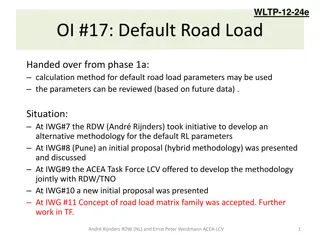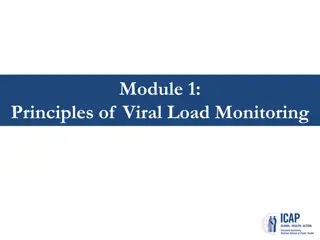
Load Testing Results Review and Recommendations for SBCTC PeopleSoft System
Explore the comprehensive load testing results, recommendations, and findings for the SBCTC PeopleSoft system, including scope, approach, assumptions, and configurations. The report delves into testing performed on technical components, user transactions, system limitations, infrastructure changes, and more to enhance service delivery for students and employees.
Download Presentation

Please find below an Image/Link to download the presentation.
The content on the website is provided AS IS for your information and personal use only. It may not be sold, licensed, or shared on other websites without obtaining consent from the author. If you encounter any issues during the download, it is possible that the publisher has removed the file from their server.
You are allowed to download the files provided on this website for personal or commercial use, subject to the condition that they are used lawfully. All files are the property of their respective owners.
The content on the website is provided AS IS for your information and personal use only. It may not be sold, licensed, or shared on other websites without obtaining consent from the author.
E N D
Presentation Transcript
SBCTC PeopleSoft Load Testing Results Review Final Run Edited Feb. 8, 2022 Prepared by Kastech Software Solutions Group
Agenda v Scope Approach Assumptions Findings Results Based on Recommendations Key Takeaways 2
Scope of the Project v Perform load testing on the technical components of ctcLink (App, Web, database and network) and ensure application works as expected under heavy loads. Verify prior recommendations provided during DG2/3 and confirmed with DG5. Perform the test in Production-like environment, with infrastructure scaled to prior recommendation state at the commencement of the load test. Ensure the PeopleSoft applications have adequate capacity to support anticipated user loads at DG6 deployment. Identify any new bottlenecks in the system (application, web, database and network) and ensure that application works as expected under predefined loads. Determine application limitations under maximum number of active users performing common transactions. Provide documentation on any changes recommended to improve service and delivery for students/employees using the PeopleSoft environment. 3
Approach v Include most frequently used transactions that might have potential impact to the load on the system. Test system with 30% above the current production population anticipated for DG2, DG3, DG4, DG5 & DG6. 25% Student Population/50% Employee Population of All Colleges are being considered for Final Load Testing. Include Fluid User Interface transactions which includes FA and SF transactions. Execute multiple user type scripts (Student, Faculty, Staff, Employee and Manager). Follow an incremental/Iterative approach and identify the break points for predefined load. Burgundy team to monitor the servers/infrastructure on AWS and make changes according to the load. Number of Load users by Application & User Type Student 35,000 CS Faculty 4,000 CS Staff 4,000 CS Employee 12,000 HR HR Manager 1,500 FIN Procurement Finance Accountant 300 4
Assumptions v Testing to be performed on SBCTC AWS production-like environment to meet the loads of students and staff. All tests were executed through Interaction HUB portal. Recommendations were provided based on the Final Load. Changes to infrastructure in the future should be relative to the future state anticipated loads. 5
CurrentProduction vs Recommended Configuration v DG5 Round Count 24,000 4,000 4,000 Final Round Count 35,000 4,000 4,000 Pillar User Type CS CS CS Student Faculty Staff Portal Campus Parameter Recommended Config* Recommended Config* Current Current Number of Application server Instances 2 48 6 128 Number of Webserver Instances 2 48 6 128 Number of Application server processes 8 48 8 128 DB instance Size m5.large m5.8xlarge m5.2xlarge db.m5.12xlarge Jolt min handlers 8 50 8 50 Jolt max handlers 12 70 12 70 Recycle count 4,000 2,500 4,000 2,500 6 * Recommendations from DG5 round remain confirmed.
Key Takeaways Search for Open Class using Elastic Search v Run With Recommended Settings At Original Ramp-Up Time (Ramp-up time is 0.01 sec) After Adjusting Ramp-Up Time (Ramp-up time is 0.10* sec) Load Testing with 35,000 students: 99.66% of the student transactions were executed successfully Only 0.34% of the student transactions failed. Load Testing with 10,000 student increment: 49.67% of student transactions were executed successfully. 50.33% of student transactions failed. * Recommended Ramp-up Time by Managed Services 7
Results Before and after implementing Suggestions v Below are the results for Search for Open Class transaction. This is with Elastic Search. Test script was executed through iHub for 35,000 users with a ramp-up of 0.1 seconds. Managed Services team reiterated no config change is needed to fix failure when we tested with ramp-up of 0.01 sec per user, since this is not a real-time scenario. So we changed ramp-up to 0.1 sec With Recommended Config 49.67% students were able to perform the transaction successfully. 50.33% students were dropped out at multiple stages of transaction. Reasons for failure: Web server not available/not responding. Gateway timeout Bad Gateway 99.66% students were able to complete the transaction successfully. 0.34% students were dropped out. 8
CS Results Student Scripts v Error % S.No Transaction Name Key Takeaway: Current Production environment set to handle 8K 1.22 Login into CS 1 student load and positioned to scale to handle 35K student load. 1.05 Course Search with 2 criteria 2 NA Register for Four (4) Classes 3 Details 0.14 View Grades 4 All scripts were executed through iHUB portal 0.09 View Financial Aid 5 Student transactions were tested for 35,000 users with a NA Add 4 Courses 6 ramp-up of 0.01 seconds NA Ad hoc add course* 7 Current Production average user load is around 1500 in an NA Ad hoc* 8 hour NA Drop Class 10 * Note: Two transactions in BOLD were successful when tested NA Swap Class 11 with 64 servers for 8,000 students; equivalent to 128 servers for NA Calendar Inquiry 12 35,000 students. 128 Servers scenarios will likely not happen 0.53 Modify Personal Data 13 0.00 Account Inquiry (SF) 15 until we go live with all 34 colleges. 9 0.30 View Class Schedule 16 0.34 Search for Open Class 17
CS Results Faculty Transactions v Error % S.No Transaction Name Key Takeaway: Current Production environment sized to handle the 4K load 0.44 Lookup teaching schedule 1 Details All scripts were executed through Interaction HUB 0.00 Lookup advisee schedule 2 portal Faculty and staff tested for 4,000 users with a 0.38 Lookup advisee grades 3 ramp-up of 0.1 seconds 0.37 Modify Bio/Demo 4 0.46 Search Classes 5 0.28 View Student Account 6 0.15 Lookup Class Roster 7 10
FSCM (FIN) New Configuration Results v User Type Count 300 Procurement/Finance/Accountant FSCM FSCM S.No Transaction Name Load Error % Parameter (Recommended Config) (Current Prod) 1 300 0.48 Create PO Number of Application server Instances 2 300 0.00 Enter Change Order to PO 2 48 3 Create Voucher 300 0.29 Number of Webserver Instances 2 48 4 Create Journal 300 1.09 5 Enter Suppliers 300 0.00 DB instance Size m5.2xlarge m5.8xlarge 6 Update Supplier 300 0.00 Jolt min handlers 8 50 7 300 0.30 Delete Supplier Jolt max handlers 12 70 8 Journal Edit 300 0.33 No. of Application server processes 8 40 9 Journal Post 300 0.51 10 Create Requisitions 300 0.00 Recycle count 4000 2500 11 Key Takeaway: Recommended Settings confirmed to handle the FSCM Load
HCM Load Testing v All the tests are done through Interaction HUB portal. Tests were performed on 12,000 employees and 1,500 Managers with ramp-up period of 0.1 seconds. Pillar User Type Counts HCM Employee 12,000 HCM Manager 1,500 12
HCM - On Recommended Configuration v Parameter HCM (Current Production) HCM (Recommended Configuration) Number of Application server Instances 24 48 Number of Webserver Instances 24 48 DB instance Size m5.xlarge m5.4xlarge Jolt min handlers 8 50 Jolt max handlers 12 70 No. of Application server processes 8 40 Recycle count 4,000 2,500 Employee Transactions Manager Transactions S.No Employee Transactions Error % S.No Managers Transactions Error % 0.21 View Paycheck 1 0.07 Job Data Inquiry 1 0.12 View W2 2 0.12 Promotions 2 0.23 W2 Consent 3 0.03 Terminations 3 0.13 Submit W4 Tax 4 0.02 Transfer 4 0.06 View Dependent Beneficiaries 5 0.68 Address Change 5 0.08 View Benefits summary 6 13 Key Takeaway: Recommended Settings confirmed to handle the Manager and Employee Self-service Load
FA/SF Results Using New Configuration v S.No Managers Transactions Error % These are the results for FA/SF module. Fluid UI-Payment History 1 0.00 Test script was executed through iHub for 35,000 users with a ramp up of 0.01 seconds. Fluid UI-Account Summary Page 0.00 2 SS-Fluid-1098T 0.05 3 Since environment was sized already with CS tower, all the scripts were executed successfully with < 1% errors. Charges Due Page 0.06 4 SS-Fluid-Make a Payment 0.09 5 Fluid UI-College Financing Plan 0.05 6 Fluid UI 0.01 7 Fluid UI-Inquiry Data Page 0.87 8 Fluid UI-FA Landing Page 0.87 9 Fluid UI-Disbursements 0.27 10 14 Key Takeaway: Recommended settings confirmed to handle 35,000 Student load
Key Takeaways - Summary v On an average, errors went down by 95% based on our findings and recommended settings (from prior test round). Kastech recommends scaling up to the recommended settings in advance of peak periods. A key outcome of Load testing is proactively monitoring Load and working with Managed Services to request changes to settings. Because SBCTC is not currently using AWS autoscaling, the Managed Services team must intentionally scale up before the increased Load hits so the Load can be managed. Kastech recommends to maintain recommended setting whenever there is an anticipated load increase to avoid any disruption of application. Load-balancer server prior to recommendation was not distributing the load among multiple servers equally. The issue has been addressed. If SBCTC thinks the overall cost to maintain the recommended configuration is too high, data analysis can be carried out after six months or one year to identify the total load on the system and configuration can be modified accordingly. Kastech recommends to turn on the autoscaling feature on AWS. 15






















